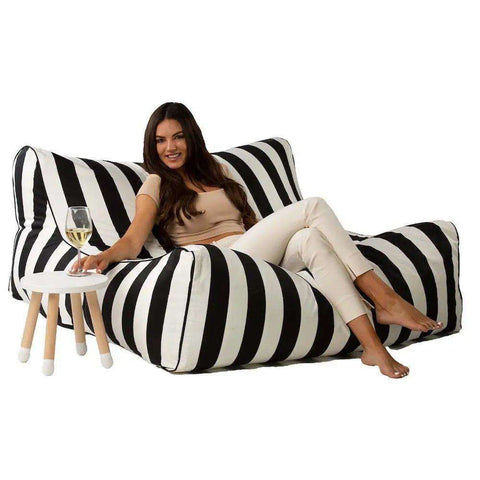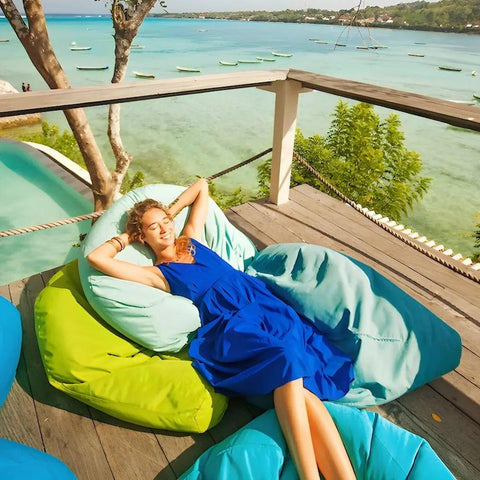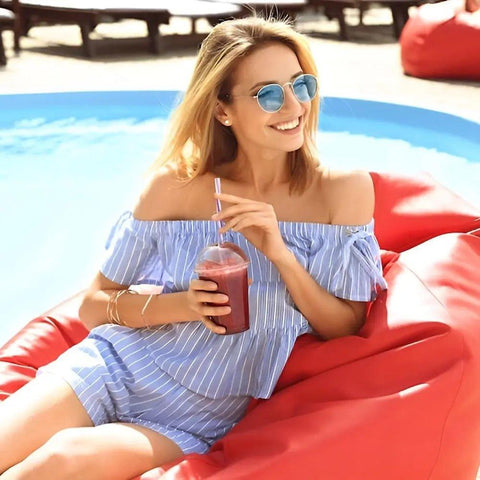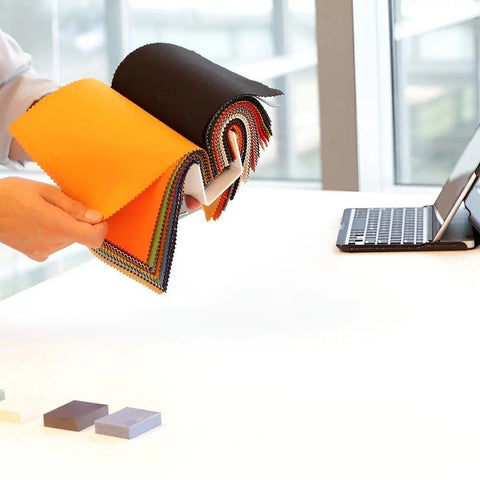UV-induced fabric fading can wreck your outdoor furniture. Find out how to stop fabric from fading in this in-depth post
Outdoor furniture can quickly lose its vibrant look if exposed to sunlight. Fading fabric is a common problem, but there are effective ways to protect your investment. This guide explains how to prevent fabric fading, what makes a fabric UV-resistant, and which materials work best outdoors.
Why Does Fabric Fade in the Sun?
Ultraviolet (UV) rays from the sun break down the chemical bonds in fabric dyes. UV rays trigger a chemical reaction with the dyes and fibres in fabrics, leading to fading and material degradation. Over time, this causes colours to fade and materials to weaken. Even on cloudy days or in winter, UV rays can still damage your outdoor furniture.
What Is UV-Resistant Fabric?
UV-resistant fabric is designed to withstand sunlight without fading quickly. Sun-resistant fabric is specially designed to block UV rays and the sun's rays, helping to prevent fading and maintain colour. These fabrics are rated by their Ultraviolet Protection Factor (UPF). A UPF of 50 means the fabric blocks 98% of the sun’s rays. Anything above 50 is considered excellent protection. Solution-dyed polyester is effective in preventing UV-induced fading due to its colour particles embedded in the fibre.
How Do Manufacturers Make Fabrics UV-Resistant?
-
Additives: Special molecules are mixed into the fabric before it is made. These help reflect or absorb UV rays and do not wash out.
The type of dye used, including the use of vibrant dyes, and how they are applied to different fabrics like silk, lace, chiffon, or cotton, can significantly impact how well these fabrics resist fading from sun exposure.
-
Dark Colours: Darker fabrics absorb more UV rays, offering better protection than lighter colours.
-
Blockers: Pigments like titanium oxide or carbon black are added to block UV light.
-
Absorbers: Chemicals such as benzotriazoles or nano zinc oxide absorb UV energy and turn it into heat.
-
Stabilisers: These chemicals trap free radicals created by UV exposure, preventing further damage.
-
Tight Weaves: Fabrics with tightly packed fibres let less UV light through.
How to Prevent Your Fabrics from Fading
-
Protect Furniture Year-Round: UV rays are present all year, even in winter or on cloudy days. Always protect your furniture, not just in summer—proper storage of furniture and clothes when not in use is essential to prevent fading and sun damage.
-
Use Covers: High-quality covers made from UV-resistant materials can block sunlight and keep your furniture looking new. Shield fabrics or covers can provide an extra layer of protection against UV rays.
-
Choose the Right Materials: Look for furniture made with UV-resistant fabrics like solution-dyed polyester, nylon, or acrylic. See our outdoor bean bag collection. Synthetic materials are often more resistant to fading than natural fibres, while delicate fabrics such as silk or lace may require additional protection from sun exposure.
-
Add Shade: Use pergolas, awnings, or umbrellas to reduce direct sunlight. UV window film can also help indoors. Lighter shades of fabric are more prone to yellowing or fading from sun exposure.
-
Rotate Furniture: Move and flip cushions regularly to ensure all sides receive equal sun exposure, slowing down uneven fading. Minimising prolonged exposure to direct sunlight helps prevent uneven fading and fabric deterioration.
-
Use UV-Protective Sprays: Use UV-protective sprays or window films to shield fabric from sunlight. Choose eco-friendly UV protection sprays, and consider air drying or line drying fabrics in the shade to reduce sun damage and fading.
Proper washing and ensuring fabrics are fully washed and dried before storage can help maintain their colour and prevent fading.
Can You Add UV Protection After Buying?
If your furniture doesn’t have built-in UV protection, you can use a UV fabric protection spray. A UV spray can be applied to fabrics to block UV rays and help prevent fading. These sprays act like sunscreen for your fabrics, blocking UVA and UVB rays. Using UV-blocking sprays can significantly extend the lifespan of your fabrics by protecting them from sun damage. Always follow the manufacturer’s instructions and test on a small area first.
Best Outdoor Fabrics for Sun Resistance
|
Fabric Type |
UV Resistance |
Best Use |
|---|---|---|
|
Solution-Dyed Polyester |
Excellent |
Outdoor cushions, |
|
Nylon (Type 6 or 12) |
Very Good |
High-wear furniture, covers |
|
Ripstop (Polyester-Nylon Blend) |
Good |
Bean bag covers, tents |
|
Excellent |
Premium outdoor upholstery |
Sun-resistant fabric is ideal for outdoor clothing and accessories, as it helps protect garments from UV exposure, maintains colour, and ensures long-lasting durability even with frequent sun and weather conditions. Choosing sun-resistant fabrics with high UV protection ratings, such as UPF, is essential for both outdoor furniture and clothing.
Can You Use Scotchgard on Outdoor Fabrics?
Scotchgard can protect outdoor fabrics like nylon, canvas, polyester, and leather. It can also help protect these materials from fading due to sunlight. Always check with the manufacturer first. If unsure, test on a small hidden area to make sure the colour does not change.
What Materials Qualify as UV-Protective?
To be considered UV-protective, a fabric should have a UPF of at least 15. Here’s how UPF ratings are classified:
-
15–24: Good
-
25–39: Very Good
-
40+: Excellent
While UPF ratings measure protection from UV rays, it's important to note that visible light and X-rays are also part of the solar spectrum. However, UV rays are the primary cause of fabric fading and deterioration.
If you live in a sunny region, aim for a UPF of 30 or higher for the best protection. Learn more about sun intensity in the tropics.
Caring for Fabric Furniture
Properly caring for fabric furniture is essential to keep it looking fresh and vibrant, especially when it’s exposed to harmful UV rays. Direct sunlight can cause even the most beautiful fabrics to fade over time, so it’s important to take proactive steps to protect your investment. Start by choosing UV-resistant fabric or applying UV protection sprays to shield your furniture from the sun’s rays. These products create a protective barrier that helps prevent fading and colour loss.
Regular maintenance is also key. Vacuum your fabric furniture frequently to remove dust and debris, and spot clean any spills as soon as they occur. This not only keeps the fabric looking its best but also helps maintain its durability. For added protection, avoid placing your furniture in areas with prolonged sun exposure, or use fade-resistant fabric for pieces that are likely to get a lot of sunlight. By combining UV protection with routine cleaning and smart placement, you can significantly extend the life and appearance of your fabric furniture.
Outdoor Fabric Maintenance
Outdoor fabrics face constant exposure to UV rays and changing weather, so they require special care to stay in top condition. Solution dyed polyester and solution dyed acrylic are excellent choices for outdoor fabrics because their colour is locked into the fibres, making them highly resistant to fading. To further protect your luxury outdoor bean bags, consider using UV protection sprays or selecting items with built-in UV protection.
Regularly inspect your outdoor fabrics for signs of wear or damage, and clean them according to the manufacturer’s instructions. Promptly address any issues, such as small tears or stains, to prevent them from worsening. By combining high-quality materials with consistent maintenance and UV protection, you can prevent fading and keep your outdoor fabrics looking vibrant and inviting for years to come.
Tips for Outdoor Fabric Care
Keeping your outdoor fabrics in great shape is easy with a few simple strategies. First, always opt for fabrics with built-in UV protection or treat them with UV protection sprays to guard against harmful UV rays. Limiting prolonged sun exposure by providing shade—using umbrellas, pergolas, or awnings—can also help block the sun’s rays and prevent fading.
When it comes to cleaning, use a mild detergent and cold water to gently wash your fabrics, and avoid harsh detergents or bleach, which can weaken fibres and strip away colour. For best results, air dry your fabrics rather than using high heat, which can accelerate fading. If possible, choose fade-resistant fabric or apply a UV-resistant coating to help maintain the original colour and vibrancy. With these tips, you can protect your outdoor fabrics from sun damage and keep them looking their best season after season.
The Importance of Sun Protection
Sun protection is vital for preserving the quality and appearance of fabrics, especially those exposed to direct sunlight. UV rays can break down the chemical bonds in dyes and fibres, leading to fading, weakened materials, and loss of the original colour. Using UV-resistant materials like solution-dyed polyester or solution-dyed acrylic provides a strong defence against this kind of sun damage.
Applying UV protection sprays or choosing fabrics with built-in UV protection adds an extra layer of security, helping to block or absorb UV radiation before it can harm your fabrics. Prioritising sun protection not only helps prevent fading but can also significantly extend the lifespan of your clothing and furniture. By taking these steps and maintaining your fabrics regularly, you’ll keep them looking vibrant and new, even after extended periods of sun exposure.
Conclusion
While no fabric is completely sunproof, you can slow fading by choosing UV-resistant materials, using covers, adding shade, and rotating your furniture. For the best results, select synthetic fabrics like nylon, polyester, or acrylic, and always check the UPF rating before buying. Acrylic solution-dyed fabrics are infused with colour particles to prevent fading from sunlight exposure.






